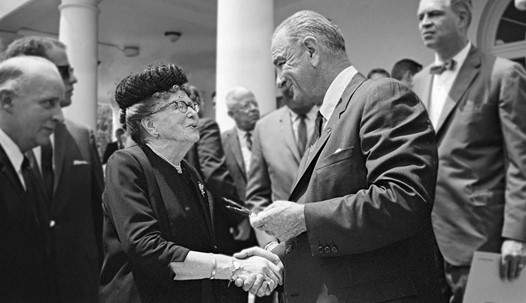
The Older Americans Act (OAA) was first passed in 1965 as part of President Lyndon Johnson’s “Great Society” initiative, with the goal of supporting older Americans to continue living at home and in their community with dignity and independence for as long as possible. It authorized a wide range of services, including home-delivered meals, support for family caregivers, preventive health services, personal and home care services, transportation, legal assistance, elder abuse prevention and more.
A variety of changes have been made to the OAA over the years, and it has been reauthorized with minor tweaks several times, most recently in 2020. But its overarching purpose has remained the same.
While this landmark legislation has dramatically improved the lives of millions of older Americans over the past half-century-plus, it has a glaring weakness: The OAA contains no provisions specifically aimed at promoting the independence and well-being of older adults with sensory disabilities. We now have an opportunity to address that gap.
“The OAA has had an incredible impact for more than half a century,” says Council Executive Director Denise Jess. “But the characteristics and needs of our aging population have shifted since the mid-‘60s. We need the program rules to reflect those changes. That includes explicitly addressing vision loss in federal, state and area plans that impact older adults.”
Earlier this year, the Administration for Community Living (ACL), which administers most of the OAA programs, proposed updates to the regulations governing these programs, and over the summer they gathered public input on the proposed updates. Two national networks the Council participates in — VisionServe Alliance (VSA) and the Aging and Vision Loss National Coalition (AVLNC) — submitted comments to ACL aimed at ensuring that adults with age-related vision loss and other sensory disabilities can access appropriate supports through the OAA.
The rule changes proposed by ACL include:
- Clarifying requirements for state and area plans on aging and for coordination among tribal, state and local programs.
- Strengthening provisions related to prioritizing people with the greatest social and economic needs.
- Specifying the range of people who can receive services, how funds can be used, and other requirements that apply across programs.
- Clarifying required state and local policies and procedures.
- Addressing emergency preparedness and response, incorporating lessons from the COVID-19 public health emergency.
- Establishing expectations for legal assistance and activities to prevent elder abuse.
- Clarifying the role of the aging network in defending against the imposition of guardianship and in promoting alternatives.
- Updating definitions, modernizing requirements and clarifying flexibilities within the senior nutrition programs.
You can find much more information about the proposed update on the ACL website.
The comments submitted by VSA and AVLNC were grounded in statistics from the Big Data Project, a groundbreaking collaboration between VSA and researchers at The Ohio State University that collected national and state-level data on the prevalence, demographics and well-being of older adults with vision loss.
“This is an excellent example of using data to inform advocacy efforts,” Denise says. “The Big Data Project has become a tremendous asset as we push for systems change at both the federal and state levels.” More information about the Big Data Project is available on the VisionServe Alliance website.
Among the recommendations made by VSA and AVLNC:
- Add “sensory loss” explicitly to the definitions of “physical and mental disabilities” and “chronic conditions” used to identify the groups with “greatest social need.”
- Add the terms “accessible” and “accessibility” in connection with the delivery of services and information to older individuals with vision and or hearing loss.
- Include “vision rehabilitation services” to the definition of in-home professional services authorized by the OAA.
- Require state and area plans to specifically address people with sensory disabilities.
“Once the new rule is finalized, we look forward to working with state officials in Wisconsin to ensure that residents with vision loss can benefit as much as possible from OAA programs and have the best chance of maintaining their independence and dignity,” Denise says.

